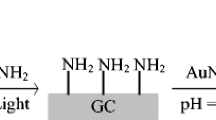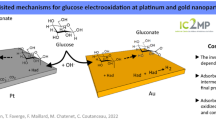Abstract
Gold is frequently regarded as the ideal metal for the investigation of solid electrode behaviour, which in aqueous media is often considered in very simplistic terms as being that of a metal which is highly resistant to dissolution. Gold possesses very weak chemisorbing properties and an extensive double layer region that in the presence of most pure electrolytes is often assumed to be totally free of Faradaic behaviour, and exhibits a monolayer (or Au2O3) oxide formation/removal reaction at quite positive potentials. However, recent investigations have revealed that the electrochemistry of polycrystalline gold in aqueous solution is considerably more complex. Two significantly different types of oxide deposits, monolayer (or α) and hydrous (or β), may be produced on the metal and the behaviour of the β-deposit is quite unusual. It is suggested that not only the behaviour of the β-oxide but, far more important from a practical viewpoint, the catalytic and electrocatalytic behaviour of gold (which will be discussed in more detail in Part II) may be rationalized in terms of the active state (or states) of gold. This active state (frequently present only at very low coverage) reacts in a manner that is quite different from that of stable gold. The nature of the active state of gold deserves far more attention than it has received to date.
Similar content being viewed by others
References
W.M.H. Sachtler,Ber. Bunsenges. Phys. Chem., 1995,99, 1295
G. Pillay and CP. Chen,J. Electrochem. Soc, 1996,143, 3410
G.M. Schwab in ‘Catalysis — Science and Technology’, Vol. 2, ed. J.R. Anderson and M. Boudart, Springer-Verlag, Berlin, 1981, p.4
T. Wolfram and S. Ellialtioglu in ‘Theory of Chemisorption’, ed. J.R. Smith, Springer-Verlag, Berlin, 1980, p.150
D. Pletcher,J. Appl. Electrochem., 1984,14, 403
J.C. Farmer, in ‘Environmental Oriented Electrochemistry’, ed. C.A.C. Sequeira, Elsevier, Amsterdam, 1994, p.565
R.D. Rochlin and R.W. Murray,J. Phys. Chem., 1981,85, 2104
L.D. Burke and J.R Healy,J. Electroanal. Chem., 1981,124, 327
L.D. Burke and T.G. Ryan,J. Appl. Electrochem., 1990,20, 1053
L.D. Burke,Electrochim. Acta, 1994,39, 1841
L.D. Burke and RE Nugent,Electrochim. Acta, 1997,42, 399
R. Woods, in ‘Electroanalytical Cliemistry’, Vol. 9, ed. A.J. Bard, Marcel Dekker, New York, 1976, p. 1
G. Belanger and A.K. Vijh, in ‘Oxides and Oxide Films’, Vol. 5, ed. A.K. Vijh, Marcel Deldcer, New York, 1977, p. 1
B.E. Conway, in ‘Progress in Surface Science’, Vol. 49, ed. S.G. Davidson, Pergamon, New York, 1995, p. 331
M. Pourbaix, in ‘Atlas of Electrochemical Equilibria in Aqueous Solutions’, Pergamon, Oxford, 1966, p. 399
L.D. Burke and M.E.G. Lyons, in ‘Modern Aspects of Electrochemistry’ No. 18, ed. R.E. White, J.O’M. Bockris and B.E. Conway, Plenum Press, New York, 1986, p. 169
G. Milazzo and S. Caroli, ‘Tables of Standard Electrode Potentials’, John Wiley, Chichester, 1978, p. 229
L.D. Burke, M.M. MacCarthy and M.B.C. Roche,J. Electroanal. Chem., 1984,167, 291
L.D. Burke, V.J. Cunnane and B.H. Lee,J. Electrochem. Soc., 1992,139, 399
L.D. Burke, D.T. Buckley and A.J. Morrissey,Analyst, 1994,119, 841
L.D. Burke and M. McRann,J. Electroanal. Chem., 1981,125, 387
L.D. Burke and G.E Hopkins,J. Appl. Electrochem., 1984,14, 679
A.C. Chialvo, W.E. Triaca and A.J. Arvia,J. Electroanal Chem., 1984,171, 303
L.D. Burke, M.E. Lyons and D.R Whelan,J. Electroanal. Chem., 1982,139, 131
N.C. Brady, ‘The Nature and Properties of Soils’, 10th Edition, Macmillan, New York, 1990, p. 177
L.D. Burke, M.E. Lyons, E.J.M. O’Sullivan and D.P. WhelanJ. Electroanal Chem., 1981,122, 403
L.D. Burke and K.J. O’Dwyer,Electrochim. Acta, 1989,34, 1659
L.D. Burke and P.F. Nugent, to be published
L.D. Burke and A.J. Morrissey,J. Appl. Electrochem., 1996,26, 593
L.D. Burke and J.M. Moran, to be published
R.J. Nichols, D.M. Kolb and R.J. Behm,J. Electroanal Chem., 1991,313, 109
M.T. Reetz, W. Helbig and S.A. Quaiser, in ‘Active Metals — Preparation, Characterization, Application’, ed. A Fürstner, VCH, Weinheim, 1995, p. 279
L.D. Burke and B.H. Lee,J. Electroanal Chem., 1992,330, 637
G. Nguyen Van Huong, C. Hinnen and J. Lecoeur,J. Electroanal Chem., 1980,106, 185
T. Watanabe and H. Gerischer,J. Electroanal. Chem., 1981,122, 73
J. Desilvestro and M.J. Weavers,J. Electroanal Chem., 1986,209, 377
R.S. Hutton and D.E. Williams,J. Am. Chem. Soc., 1994,116, 3453
D.W. Kirk, F.F. Foulkes and W.F. Graydon,J. Electrochem. Soc., 1980,127, 1069
H. Angerstein-Kozlowska, B.E. Conway and A. Hamelin,Electrochim. Acta, 1990,277, 233
H. Angerstein-Kozlowska, B.E. Conway, A. Hamelin and L. Stoicoviciu,Electrochim. Acta, 1986,31, 1051
H. Angerstein-Kozlowska, B.E. Conway, A. Hamelin and L. Stoicoviciu,J. Electroanal. Chem., 1987,228, 429
H. Angerstein-Kozlowska, B.E. Conway, B. Barnett and J. Mozota,J. Electroanal Chem., 1979,100, 417
L.D. Burke and W.A. O’Leary,J. Appl. Electrochem., 1989,19, 758
G. Horanyi and E.M. Rizmayer,J. Electroanal Chem., 1984,165, 279
J.S. Gordon and D.C. Johnson,J. Electroanal. Chem., 1994,365, 267
W. Kautek, M. Sahre and D.M. Soames,Ber Bunsenges. Phys. Chem., 1995,99, 667
T Zambelli, J. Winterlin, J. Trost and G. Erd,Science, 1996,273, 1688
L.D. Burke,Platinum Metals Rev., 1994,38, 166
A. Henglein,Ber. Bunsenges. Phys. Chem., 1995,99, 903
F. Parmigiani, E. Kay and P.S. Bagus,J. Electron. Spectrosc. Relat. Phenom., 1990,50, 39
D.W. Suggs and A.J. Bard,J. Am. Chem. Soc., 1994,116, 10725
Author information
Authors and Affiliations
Additional information
Lawrence Declan Burke received his BSc and MSc from University College Cork in 1959 and 1961, respectively, and a PhD in 1964 from Queen’s University Belfast where he worked with EA. Lewis on the palladium hydride system. He spent a year as an Alexander von Humbolt Fellow in Karlsruhe University, Germany, where he worked on solid state electrochemistry with Professor Hans Rickert. Since returning to Cork he has been involved in an extensive investigation of the electrochemistry of metals, oxides and especially hydrous oxides. This work, which is concerned largely with the unusual or non-ideal behaviour of these systems, is relevant to such areas as electrocatalysis, electrochromic systems, electroless deposition of metals, etc. Professor Burke was awarded Fellowship of the Electrochemical Society in 1995.
Patrick Francis Nugent received his BSc degree in chemistry from University College Cork in 1992. He is currently completing his PhD degree on the electrochemistry of gold in aqueous media.
Rights and permissions
About this article
Cite this article
Burke, L.D., Nugent, P.F. The electrochemistry of gold: I the redox behaviour of the metal in aqueous media. Gold Bull 30, 43–53 (1997). https://doi.org/10.1007/BF03214756
Issue Date:
DOI: https://doi.org/10.1007/BF03214756




